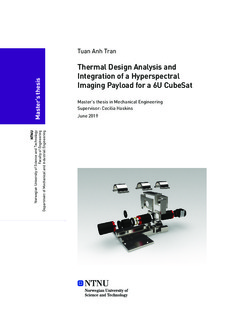| dc.contributor.advisor | Haskins, Cecilia | |
| dc.contributor.author | Tran, Tuan Anh | |
| dc.date.accessioned | 2019-10-18T14:01:47Z | |
| dc.date.available | 2019-10-18T14:01:47Z | |
| dc.date.issued | 2019 | |
| dc.identifier.uri | http://hdl.handle.net/11250/2623206 | |
| dc.description.abstract | Denne oppgaven presenterer utviklingen av et hyperspektral kamera bestående av kommersielle
off-the-shelf komponenter og tilhørende nyttelast ombord på en 6U CubeSat eid av HYPSO
prosjektet. Oppgaven fungerer som et cover for en samling av tekniske rapporter skrevet under
forskningsperioden. Rapportene gir en detaljert beskrivelse av design, tester og analyser utført
for å utvikle og integrere det hyperspektrale kameraet i tillegg til supplementerende nyttelaster.
Det optiske designet av det hyperspektrale kameraet ble utviklet av Fred Sigernes, professor i
optikk og atmosfærisk forskning ved Universitetssenteret på Svalbard. 6U CubeSat-plattformen
som vil inneholde HYPSO-nyttelastene, vil bli levert av NanoAvionics.
Under utviklingen av det hyperspectrale kameraet ble en funksjonell prototype produsert, av en
aluminiumslegering kjent som AA6082-T6. Prototypen ble satt sammen vellykket, og var i
stand til å ta hyperspektrale bilder. Prototypen ble videre testet i forskjellige termiske forhold,
som romtemperatur samt varme og kalde ekstremiteter. Fokuset forble stabilt ved
romtemperatur og de kalde temperaturene testet for. Ved temperaturer over 40 grader begynte
de hyperspektrale bildene å bli ufokuserte.
Mekaniske og termiske analyser ble utført på prototypen, og indikerte at totalstivheten til det
hyperspektrale kameraet var over kravene, mens de operasjonelle temperaturene som var
tilstede under bane rundt jorden trengte termiske styringssystemer for stabilisere nyttelasten.
De optiske kommersielle off-the-shelf komponentene som ble brukt til det hyperspektrale
kameraet ble vakuumtestet. Resultatene viste tegn til kontaminasjon av linsene som måtte
undersøkes nærmere. Store mengder fett ble funnet i de optiske komponentene, som en del av
fokus- og blenderkalibreringsmekanismen. En integrasjonsanalyse måtte gjennomføres på
komponentene for å forsikre at optisk integritet kan holdes når kameraet er i verdensrommet.
De tekniske rapportene presenterer foreslåtte designendringer og tester som må gjennomføres
for a gjøre de utviklede nyttelastene klare til romoperasjoner på HYPSO prosjektets CubeSat. | |
| dc.description.abstract | This thesis presents the development of a hyperspectral imager comprising of commercial
off-the-shelf components and the associated payloads onboard a 6U CubeSat owned by the
HYPSO project. It serves as a cover for a compilation of technical reports written during the
research period. The reports provide a detailed description of the design, tests, and analyses
conducted to develop and integrate the hyperspectral imager in additional to the supplementary
payloads.
The optical design of the hyperspectral imager was developed by Fred Sigernes, Professor in
Optics and Atmospheric Research at The University Centre in Svalbard. The 6U CubeSat
platform used to host the HYPSO payloads was provided by NanoAvionics
During the development of the launch- and space-compatible hyperspectral imager a functional
prototype was produced, using an aluminium alloy known as AA6082-T6. The prototype was
successfully assembled, being capable of taking hyperspectral images. Furthermore, the
prototype was tested in various thermal conditions including room temperature as well as hot
and cold extremities. The focus remained stable at room temperature and the tested cold
temperatures, however, started becoming unfocused at 40 degrees Celsius.
Mechanical and thermal analyses were performed on the prototype, indicating that the total
stiffness of the hyperspectral imager payload was above the requirements, while the operational
temperatures present during orbit would necessitate thermal control systems for the payload.
The optical commercial off-the-shelf components used for the hyperspectral imager were
vacuum tested. The results showed signs of contamination of the lenses that had to be further
investigated. Large amounts of grease were found inside the optical components, as part of the
focus and aperture calibration mechanism. Following this, and integration analysis had to be
conducted on the components to make sure optical integrity could be kept in the space
environment.
The technical reports presents proposed design changes and tests needed in order to make the
developed payloads ready for space operations onboard the HYPSO CubeSat. | |
| dc.language | eng | |
| dc.publisher | NTNU | |
| dc.title | Thermal Design Analysis and Integration of a Hyperspectral Imaging Payload for a 6U CubeSat | |
| dc.type | Master thesis | |
